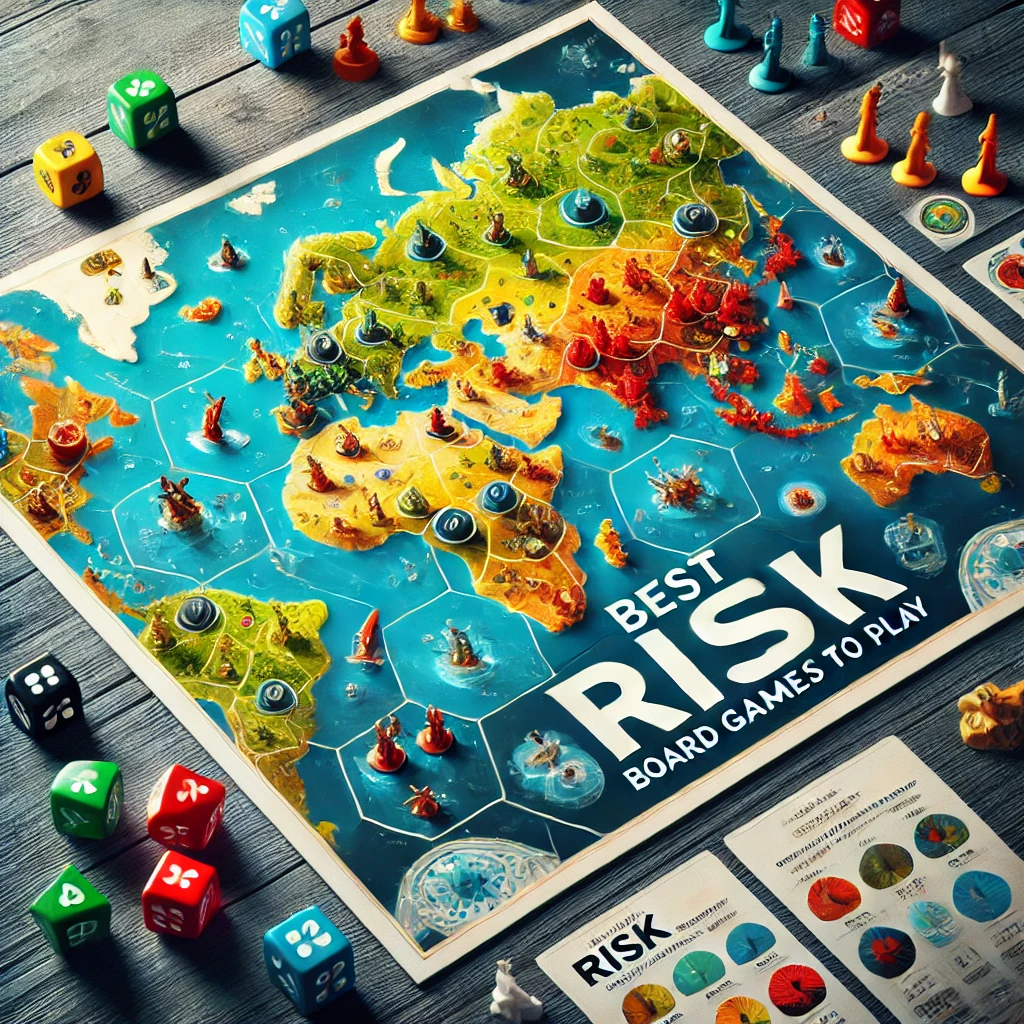Best Risk Board Games: Top Picks for War Gamers
For those who love war games, Risk is a timeless classic that continues to be very popular. Whether you’re a veteran looking to explore new variations or a beginner diving into the world of Risk-style gameplay, here are some of the best Risk board games to try!
1. Risk: Legacy

In Risk Legacy, players aim for world domination by commanding armies and conquering territories. The key difference is that every decision made during the game permanently alters future games. Stickers are placed on the board, cards are destroyed, and certain actions trigger the opening of sealed compartments, adding unpredictable changes to gameplay.
Why It’s Fun: The unpredictability and evolving nature of Risk Legacy make it highly replayable. Players can affect the game world permanently, which creates an ongoing narrative and strategic depth. This means each game feels unique, as rules can change and the game board can evolve based on player decisions. The ability to name cities, place stickers, and make permanent marks on the game gives players a sense of ownership over the game world.
Key Features:
- Permanent Changes: Every game leaves a lasting impact, from the placement of stickers to the destruction of cards.
- Sealed Compartments: These are unlocked only after certain in-game criteria are met, introducing new elements and rules.
- Faction System: Players choose from different factions, each with unique perks that affect gameplay.
- Winning Conditions: The main objective is to collect four red star coins, obtained by capturing HQs or through other strategic moves.
- Strategic Depth: Players must consider both short-term and long-term consequences when making decisions, adding complexity.
2. Risk: Lord of the Rings
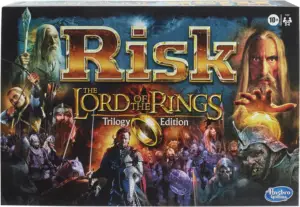
Risk: Lord of the Rings Trilogy Edition combines the classic Risk mechanics with thematic elements from The Lord of the Rings trilogy. The goal is to conquer lands and gain dominance, but it introduces additional layers such as adventure cards, leaders, strongholds, and the Fellowship ring mechanic. The game board is the map of Middle-earth, and players can play as either the good or evil forces.
Why It’s Fun: The game adds variety through adventure cards, which give bonuses and special abilities during the game. Unlike traditional Risk, the Fellowship ring mechanic adds a time-based element that limits the game length, preventing it from dragging on.
Key Features:
- Adventure Cards: Players can earn and play adventure cards that provide bonuses, reinforcements, or special effects like blocking a bridge or boosting dice rolls during battles.
- Leaders and Strongholds: Leaders boost attack or defense, while strongholds provide extra defense and reinforcements to armies stationed in them.
- Fellowship Ring Mechanic: The ring moves along a path toward Mount Doom at the end of each player’s turn, serving as a game timer. The game ends when the ring reaches Mount Doom, which adds urgency and keeps the game from being overly long.
- Good vs. Evil Armies: The game features distinct armies for good and evil, and each faction starts by claiming territories in either good or evil lands, based on card distribution.
- Ports and Geography: The game includes ports, rivers, and mountains, which affect movement and strategy, adding depth to how players navigate the board.
3. Risk: Star Wars Edition

Risk: Star Wars Edition is a Star Wars-themed strategy game that diverges significantly from traditional Risk. The game’s main objective revolves around the Rebels attempting to destroy the Death Star, while the Empire tries to eliminate all the Rebel ships. Additionally, there is a side battle between Luke Skywalker and Darth Vader, with bonuses given to the side that wins this duel.
Why It’s Fun:
- The game is quick, light, and focuses on fast-paced dice rolling, making it easy for families and casual players.
- It is highly thematic, with a clear connection to the Star Wars universe, particularly the climactic Battle of Endor.
- Players can plan their actions using a card system that introduces an element of strategy while still being luck-based with dice rolls.
- The game is enjoyable due to its Star Wars theme, the iconic scenarios, and the replayability from switching sides after each game.
- While not perfectly balanced, the thematic richness and simplicity make it fun, especially for Star Wars fans.
Key Features:
- Rebel vs. Empire Objective: The Rebels must destroy the Death Star by progressing on a track, while the Empire aims to wipe out all Rebel ships.
- Luke vs. Vader Duel: A side battle between Luke and Vader grants powerful bonuses to the winning side, either additional actions or tactical advantages.
- Card Programming: Players draw six cards and select three to play each round, introducing a light level of strategy in choosing actions.
- Dice Rolling Combat: Both space and land battles are resolved through dice rolls, with the game’s pace driven by luck and tactical decisions.
- Order Cards: Players take turns activating actions based on programmed cards, which can include advancing on the track, attacking with ships, or engaging in duels.
- Light Strategy: Although the game involves dice rolling, there is some strategic depth in managing order cards and timing actions.
4. Risk: 2210 A.D.
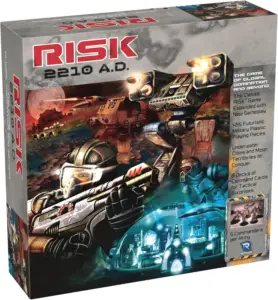
Risk: 2210 AD is a futuristic version of the classic Risk, adding new mechanics, features, and a sci-fi theme. Players control armies and attempt to dominate territories, including land, underwater regions, and the moon. The game takes place over five years (rounds), limiting its duration compared to traditional Risk. Players accumulate points based on controlled territories, special areas, and strategic objectives.
Game Mechanics:
- Area Control and Combat: Like classic Risk, players compete to control territories on the map by moving armies and engaging in dice-based combat. However, new regions such as underwater territories and the moon add more complexity.
- Commanders and Special Abilities: Players can recruit commanders (land, water, moon, nuclear) to roll higher dice or perform special actions in specific territories. This adds strategic depth to combat.
- Energy (Currency): Players earn energy each round based on the regions they control, which can be spent on commanders, space stations (which offer better defense), or powerful command cards that offer various tactical advantages.
- Cards and Commanders: Command cards introduce new abilities and actions, such as launching missile strikes or reinforcing armies. These cards, tied to specific commanders, can shift the balance of power in unexpected ways.
- Five Rounds: The game has a set time limit of five rounds, which ensures that it doesn’t drag on like traditional Risk games, and it encourages players to maximize their strategies in a limited timeframe.
- Nuclear Fallout Zones: Some territories on the map are inaccessible due to nuclear fallout, randomly drawn at the start of each game, which changes the layout and dynamics of each playthrough.
Why It’s Fun:
- The added complexity of new territories, commanders, and cards makes Risk: 2210 AD a more strategic and engaging version of the original game.
- The futuristic setting and additional features, like underwater and moon territories, offer new dimensions of strategy not found in classic Risk.
- Cards and commanders introduce an element of surprise, allowing for unpredictable and exciting gameplay moments.
- The game has a defined ending after five rounds, making it more approachable and preventing it from becoming overly long, which is a common issue with classic Risk.
5. Risk: Game of Thrones Edition
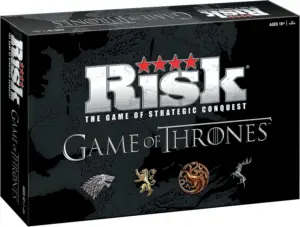
Risk: Game of Thrones merges classic Risk mechanics with the world of Westeros and Essos. Players fight for control over territories, castles, and ports, competing for dominance in a Game of Thrones setting.
Gameplay:
- Two Game Modes:
- Skirmish Mode (similar to traditional Risk): Players control territories on Westeros or Essos, collecting reinforcements, and engaging in battles.
- Domination Mode: A more complex version with characters and added thematic depth, best for larger player counts.
- Combat: Uses classic Risk dice rolling for battles, with attackers rolling three dice and defenders two. Players aim to control key areas like castles and ports for strategic advantages.
- Endgame: The game ends when the “Valar Morghulis” card is drawn, and the player with the most territories, castles, and ports wins.
Why It’s Fun:
- Thematic Units: Houses have unique pieces (Starks, Lannisters, Targaryens), enhancing immersion.
- Strategic Depth: Ports and castles add tactical layers to the battles.
- Flexible Gameplay: Two game modes cater to both casual and more strategic players.
6. Risk Strike
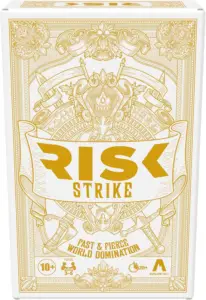
Risk Strike is a fast-paced, card-based version of Risk, where players compete for world domination by collecting continent cards and domination coins.
- Gameplay:
- Objective: Players race to collect two domination coins by gathering continent cards (e.g., eight for Asia, six for North America). Coins can be stolen if an opponent gathers more cards.
- Turn-Based: Players draw two cards per turn—continent or tactics cards. They can choose to pass (draw a tactics card) or attack an opponent.
- Combat: Attacks involve playing troop cards and rolling dice to compare results. The attacker can roll up to three dice, and the defender can roll two, with ties going to the defender.
- Tactics Cards: Special cards add variety, such as adding bonuses to dice rolls or forcing strategic decisions during attacks.
- Why It’s Fun:
- Quick and Simple: Games are fast (10-20 minutes) and easy to learn, making it accessible for casual play.
- Strategic but Light: While simplified, tactics cards and combat mechanics keep the game dynamic and engaging.
- Portable: Small game footprint, ideal for quick sessions without needing a large board or setup.
- Who Might Enjoy It:
- Fans of Risk who want a quicker, less intense version.
- Casual gamers looking for a light, fast-paced strategy game.
- People who enjoy competitive card-based games with a bit of luck and strategy.
In summary, Risk Strike offers a quick, simplified version of Risk, blending strategy and fast-pa
